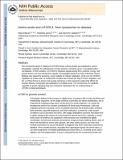| dc.contributor.author | Efeyan, Alejo | |
| dc.contributor.author | Zoncu, Roberto | |
| dc.contributor.author | Sabatini, David | |
| dc.date.accessioned | 2017-02-10T19:20:14Z | |
| dc.date.available | 2017-02-10T19:20:14Z | |
| dc.date.issued | 2012-09 | |
| dc.identifier.issn | 1471-4914 | |
| dc.identifier.uri | http://hdl.handle.net/1721.1/106904 | |
| dc.description.abstract | The mechanistic target of rapamycin (mTOR) kinase controls growth and metabolism, and its deregulation underlies the pathogenesis of many diseases, including cancer, neurodegeneration, and diabetes. mTOR complex 1 (mTORC1) integrates signals arising from nutrients, energy, and growth factors, but how exactly these signals are propagated await to be fully understood. Recent findings have placed the lysosome, a key mediator of cellular catabolism, at the core of mTORC1 regulation by amino acids. A multiprotein complex that includes the Rag GTPases, Ragulator, and the v-ATPase forms an amino acid-sensing machinery on the lysosomal surface that affects the decision between cell growth and catabolism at multiple levels. The involvement of a catabolic organelle in growth signaling may have important implications for our understanding of mTORC1-related pathologies. | en_US |
| dc.description.sponsorship | National Institutes of Health (U.S.) (Grants R01 CA129105, R01 CA103866, and R37 AI047389) | en_US |
| dc.description.sponsorship | American Federation for Aging Research | en_US |
| dc.description.sponsorship | Starr Foundation | en_US |
| dc.description.sponsorship | David H. Koch Institute for Integrative Cancer Research at MIT. Frontier Research Program | en_US |
| dc.description.sponsorship | Ellison Medical Foundation | en_US |
| dc.description.sponsorship | Jane Coffin Childs Memorial Fund for Medical Research (Fellowship) | en_US |
| dc.description.sponsorship | LAM Foundation | en_US |
| dc.description.sponsorship | Human Frontier Science Program (Strasbourg, France) | en_US |
| dc.language.iso | en_US | |
| dc.publisher | Elsevier | en_US |
| dc.relation.isversionof | https://dx.doi.org/10.1016/j.molmed.2012.05.007 | en_US |
| dc.rights | Creative Commons Attribution-NonCommercial-NoDerivs License | en_US |
| dc.rights.uri | http://creativecommons.org/licenses/by-nc-nd/4.0/ | en_US |
| dc.source | PMC | en_US |
| dc.title | Amino acids and mTORC1: from lysosomes to disease | en_US |
| dc.type | Article | en_US |
| dc.identifier.citation | Efeyan, Alejo, Roberto Zoncu, and David M. Sabatini. “Amino Acids and mTORC1: From Lysosomes to Disease.” Trends in Molecular Medicine 18.9 (2012): 524–533. | en_US |
| dc.contributor.department | Massachusetts Institute of Technology. Department of Biology | en_US |
| dc.contributor.department | Whitehead Institute for Biomedical Research | en_US |
| dc.contributor.department | Koch Institute for Integrative Cancer Research at MIT | en_US |
| dc.contributor.mitauthor | Efeyan, Alejo | |
| dc.contributor.mitauthor | Zoncu, Roberto | |
| dc.contributor.mitauthor | Sabatini, David | |
| dc.relation.journal | Trends in Molecular Medicine | en_US |
| dc.eprint.version | Author's final manuscript | en_US |
| dc.type.uri | http://purl.org/eprint/type/JournalArticle | en_US |
| eprint.status | http://purl.org/eprint/status/PeerReviewed | en_US |
| dspace.orderedauthors | Efeyan, Alejo; Zoncu, Roberto; Sabatini, David. M. | en_US |
| dspace.embargo.terms | N | en_US |
| dc.identifier.orcid | https://orcid.org/0000-0002-1446-7256 | |
| mit.license | PUBLISHER_CC | en_US |
| mit.metadata.status | Complete | |
